Review: Theatrhythm Final Fantasy (3DS)
/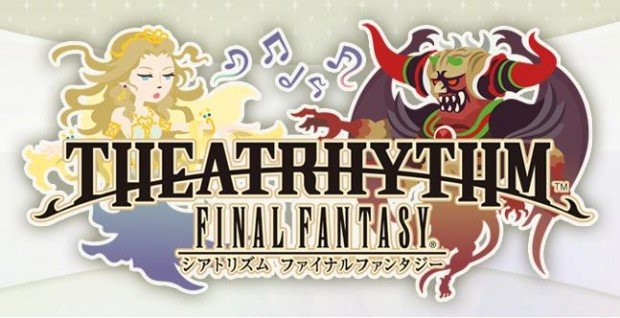 Square-Enix’s latest offering for the 3DS is none other than a rhythm title based off the beloved Final Fantasy franchise. Even as a lifelong fan of the series I’ll admit that at first I was scratching my head at the idea, thinking that this was simply another cash-in by the company to milk their fanbase, but after watching some gameplay videos that showed off the wonderful execution, I was hooked on the idea and picked it up the day of release. What I discovered surprised me in many ways.
Square-Enix’s latest offering for the 3DS is none other than a rhythm title based off the beloved Final Fantasy franchise. Even as a lifelong fan of the series I’ll admit that at first I was scratching my head at the idea, thinking that this was simply another cash-in by the company to milk their fanbase, but after watching some gameplay videos that showed off the wonderful execution, I was hooked on the idea and picked it up the day of release. What I discovered surprised me in many ways.
The Eternal Battle between Cosmos and Chaos
Continuing the spirit of the PSP Dissidia games, Theatrhythm pits the player in the midst of a feud between the two gods Cosmos and Chaos. This time, though, the battleground is Rhythm, the space connecting the two. A magic crystal (the symbol of pretty much every FF game) is the key to restoring the balance between them. By successfully completing songs with the aid of beloved Final Fantasy protagonists, the player acquires Rhythmia, returning light to the crystal and restoring the world to normalcy.
There isn’t much of a plot to the game as it relies heavily on players’ knowledge of the FF universe, but the Rhythmia gained by completing songs is used to unlock a plethora of extra modes and content. For a 3DS game, there’s a surprising amount of songs, although many of them end up being a little on the short side for quick gameplay sessions. I’ve unlocked over 70 so far, and they span the entire history of Final Fantasy, from the first game in 1987 to 2010’s Final Fantasy XIII, as the troubled FFXIV is apparently deemed unworthy of inclusion, possibly because the company is still trying to fix and re-release the title.
The game’s party system is a real treat for fans, as right off the bat you’re given the choice to form an elite party comprised of four Final Fantasy main protagonists. In true RPG fashion they can level up, equip handy abilities, use items and even have stat parameters: Strength, Agility, Magic and Luck. Strength and Magic are useful in the Battle Music mode, while Agility is helpful for reaching the prize at the end of Field Music levels and Luck determines the items you receive. I leveled-up all the characters equally, but it’s tempting to make a main team of your favorites (in my case, Squall, Lightning, Cecil and Tidus). The roster of unlockable characters does not disappoint, either.
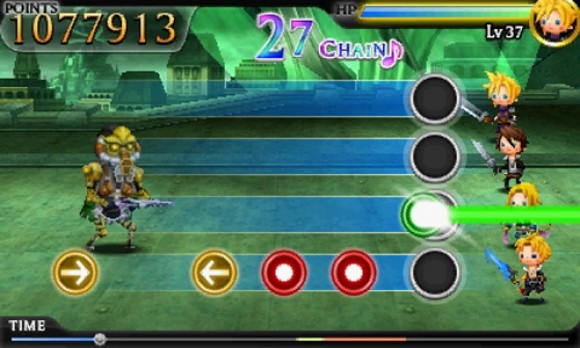
Three Gameplay Modes to Relive the Memories
The gameplay itself involves touching, sliding and holding the stylus on the touch screen in time with the music. It differs a bit depending on the type of song you’re playing (Field, Battle or Event), but the overall mechanics are dead simple. Rhythm vets who’ve played the acclaimed Elite Beat Agents or Osu! Tatakae! Ouendan! For the DS will feel right at home here. The main difference between Theatrhythm and those games is that all the action here takes place on the top screen, so you don’t have to angle your stylus around your field of vision to carefully hit marks on the bottom screen. As a result, the timing and precision of your motions is more important than pinpoint accuracy, making for a faster and cleaner, if much less demanding, rhythm experience.
In Series mode, every numbered Final Fantasy is represented with five songs, with three of them comprising the real meat of the gameplay: Field Music, which incorporates carefully chosen overworld music and maps from the game in question, Battle Music, which is faster and highlights select battle songs and enemies from each game, and Event Music, where you play a memorable song from the story mode of each game with dramatic edits of the game’s FMV sequences in the background. There are minimal differences in gameplay between these modes, but for the most part you will be performing similar actions to the beat.
The optional Intro and Ending songs are unfortunately both simple affairs relegated to timing stylus presses on the screen for Rhythmia. They’re included more for nostalgic purposes than anything else, although I would have liked for the Ending songs to be more fleshed-out, gameplay-wise.
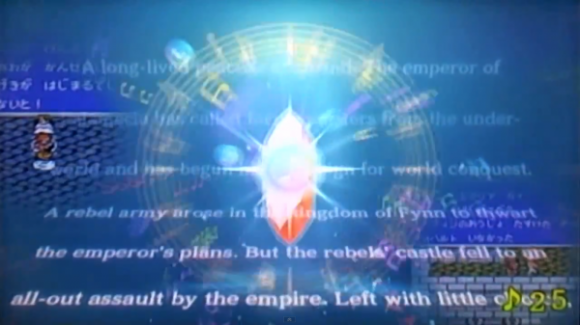
My only complaint about Series mode is that the songs are fairly easy and as an Elite Beat Agents addict, I S-ranked many of those most familiar to me on the first try.
Thankfully, in Challenge mode you have the option of playing on the Challenge and Ultimate difficulties, which up the note speed and count significantly. Getting an S-rank on Ultimate involves memorization and lightning-fast reflexes and may even leave you with carpal tunnel syndrome. As you acquire more Rhythmia throughout the game, more and more classic songs become available to play. The way the game keeps pushing the player towards mastery makes each new acquisition feel like you’ve really earned it.
To date, I’ve spent over 30 hours with the game and still haven’t unlocked every extra song. There’s paid DLC as well, a first for the Nintendo handheld. I intend to purchase some additional songs once I unlock every other track in the game.
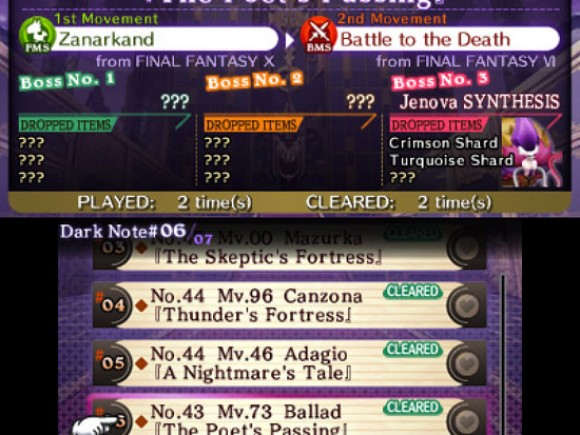
The third and most unique gameplay mode are the Dark Notes, which randomly combine a Field Music level with a Battle Music level. This is the true gauntlet of the game, where each Dark Note you play becomes more challenging. Each of the Dark Notes has a different note layout, making for a virtually endless amount of possibilities. What surprised me was that some of the Dark Notes are more fun to play and master than the actual songs, and each of them has three separate bosses to face, with three items each. Many of the bosses carry crystal shards that unlock secret characters, so there’s a lot of incentive to master these, and it’s possible to store up to 99 Dark Notes in the system’s memory. The ability to save your favorites makes it easy to organize them and ensure you don’t accidentally delete your top picks.
There’s also a local multiplayer mode supporting between 2 and 4 people. I was unable to try this out since I don’t know anyone else with a 3DS nearby. The game also supports the 3DS’ StreetPass feature, allowing players to swap favorite Dark Notes with passing travelers. Unfortunately there’s no online options, but perhaps that’s inevitable given that lag will easily break a rhythm game.
Fan service from beginning to end
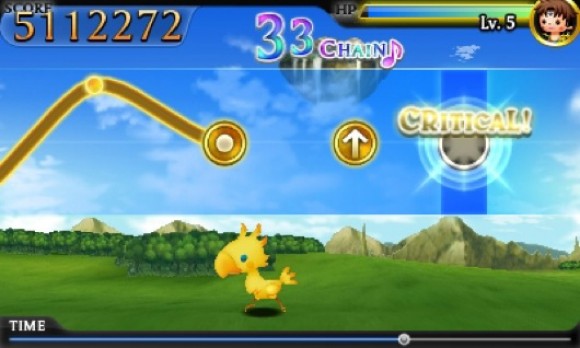
As if the three main gameplay modes weren’t enough, developers Indieszero really pulled out all the stops in order to make this game a love letter to the fans, packing the title with tons of goodies. There’s a large Museum where you can view edits of FMV sequences from the series’ games, fill out a scrapbook of cards that doubles as a dossier for the characters and enemies and can be leveled up to Holofoil status, and listen to the game’s many songs. Within the Museum’s log, Theatrhythm also drops hints as to what you have to do in order to reveal more content and earn Trophies. I didn’t expect to get so much play time out of a handheld rhythm title, but I found myself staying up late nights till my 3DS’ battery died, playing my heart out to unlock the extra goodies.
Part of what makes the game so addicting is the inviting presentation. The characters are drawn in an adorable hand-drawn sprite style that completely fits, tying twenty-five years of classic RPG worlds together in one chibi universe. The backgrounds in the Field Music stages take you back to the overworld maps of your favorite games and even give you the chance to ride a chocobo, while the Battle Music levels recreate some of the more memorable boss battle locations. These battles are where the game’s simple but effective art style really shines, as each successful note hit results in an attack and builds towards the casting of magic spells. During each battle there’s a chance to summon a Guardian Force (GF) to assist your party by scoring high enough during “Feature Zone” segments. Ifrit, Ramuh and Shiva all look fantastic and the presentation is fun and cinematic without interfering with the core gameplay. Even in the menus, the graphics are bold, crisp and lively.
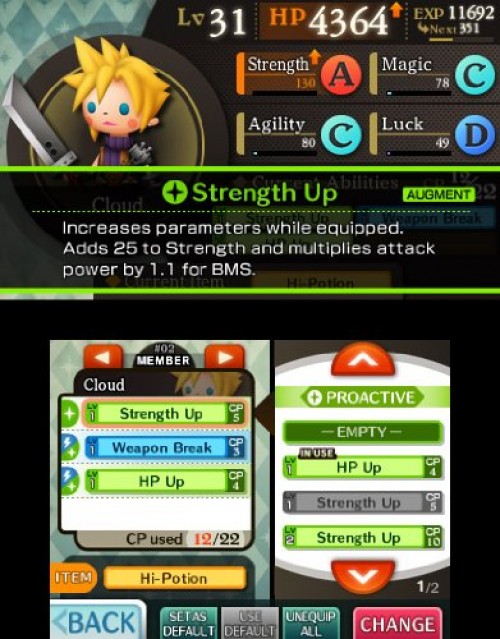
Perhaps the most surprising and useful touch is how the 3D is used. With the slider up, the notes themselves pop out in 3D, making it easier to distinguish them from the background, especially when things tend to get chaotic. I played the game as much as possible in 3D and hardly ever noticed the subtle effect, but without it my accuracy faltered.
Whether the quality of the game’s music would be up to snuff was one of my biggest reservations, but the 3DS does an impressive job. There’s very little discernable compression on the audio tracks, a big problem with rhythm games on the DS. I’m pleased to report that I encountered no clipping; the songs here are of much higher fidelity. Dedicated series composer Nobuo Uematsu would be proud, and indeed I read that playing the game was a real emotional journey for him. The tunes sound great all around, even through a decent pair of speakers, and the sound effects are never distracting. I also very much appreciated the option to determine how loud the chimes sound whenever you hit a correct note. It may sound like a small concern, but you hear the sound so often during gameplay that the ability to turn it down is a major blessing that I hope other rhythm developers emulate in the future.
A fantastic rhythm game you don’t want to miss
What I had expected to be a cheap cash-in turned out to be the most-played game on my 3DS so far this year. This is the handheld sleeper hit of the summer. My only real complaints are that the Series mode is too easy, most of the songs are a little on the short side, and some of my favorite tracks and characters didn’t make the cut. But for the amount of content available, the game is a great value.
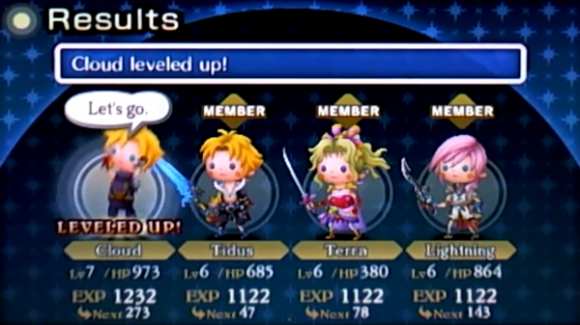
My recommendation is simple: if you have a 3DS and if you are or used to be a Final Fantasy fan, there’s no point in waiting any longer. Pick up Theatrhythm right now. Don’t even finish this review. Head to the nearest mall and grab your title before it becomes a collector’s item.
Even if you’re a Final Fantasy fan with no experience in rhythm games, there’s a very good chance this will be the title that turns you into a lover of the genre.
Conversely, however, if you enjoy rhythm games but don’t have any experience with Final Fantasy and plan to play any of the series’ wonderful games in the future, I would recommend playing between three and five Final Fantasy titlesbefore tackling this one. For one, there are some massive story spoilers in the Event Music sequences. On top of that, if you’re unfamiliar with the worlds, music and characters, you’re kind of missing out on the true joys of this game. And lastly, if you’ve no interest in Final Fantasy but simply love tapping to the beat, then by all means, take the plunge.
Score: 92/100
Pros:
- Great song selection
- Over 30 hours of addicting rhythm gameplay
- Astounding amount of extras and unlockable content
Cons:
- Songs are generally short
- Series mode is way too easy
- The game isn’t made for anyone who isn’t already a fan of Final Fantasy

